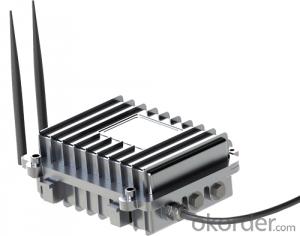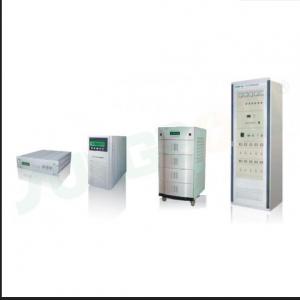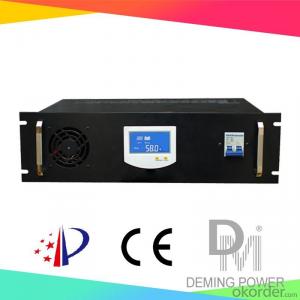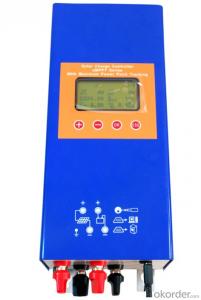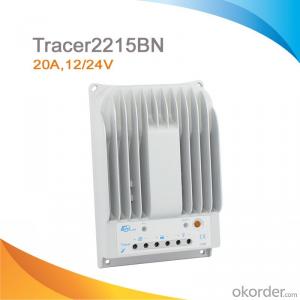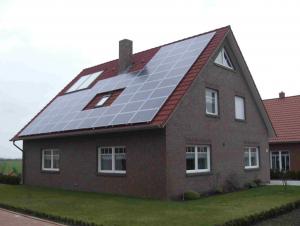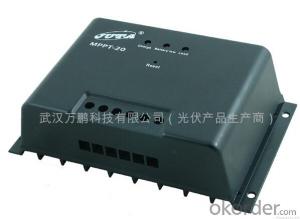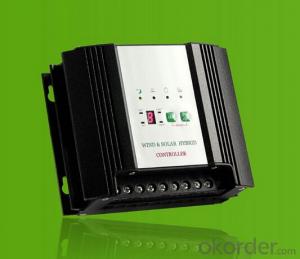IoT Wireless Centralize Controller Remote Monitor System MPPT Solar Charge Controllers 20A
- Loading Port:
- China main port
- Payment Terms:
- TT OR LC
- Min Order Qty:
- 1 pc
- Supply Capability:
- 10000 pc/month
OKorder Service Pledge
OKorder Financial Service
You Might Also Like
1. Features :
*Used GPRS communicate,support 850/900/1800/1900MHz four bands.
*Collection the data of single lamp, protocol conversion, data uploaded to the monitoring system, sending commands to the single lamp controller.
*Combined GPRS communication technology, remote monitoring anytime and anywhere.
*Used zigBee wireless mesh networking technology, support unicast and broadcast mode.
*The standard of industrial products, industrial grade aluminum alloy shell, anti-interference, durable, easy to install.
*The intelligent concentrator routing algorithm
*Support SMS control and setting
*Support ASE128 encryption algorithm
*Support remote online upgrade
*Excellent electromagnetic compatibility, system can work accurately under high voltage pulse, strong magnetic and electrostatic, lightning surge and range temperature variation.
*IP65 waterproof grade
2. Technical parameters
Parameter name | GPRS Concentrator parameter value |
Mode | Depower-DTU |
Power supply | 9~30V |
Operating bands | GPRS |
modulation mode | TCP/IP |
maximum transmit power | EGSM900/GSM850 Class4(2W) |
GSM1800/GSM1900 Class1(1W) | 14≤Vmp≤35(12V), |
Reception sensitivity | <-107dBm |
Wireless | 50Ω/SMA(Female head) |
line-of-sight transmission | Global |
Working temp | -30℃ ~ +75℃ |
Size(exclude antenna) | 113(mm) × 85(mm) × 43(mm) |
Weight | 0.92kg |
3. Detailed image
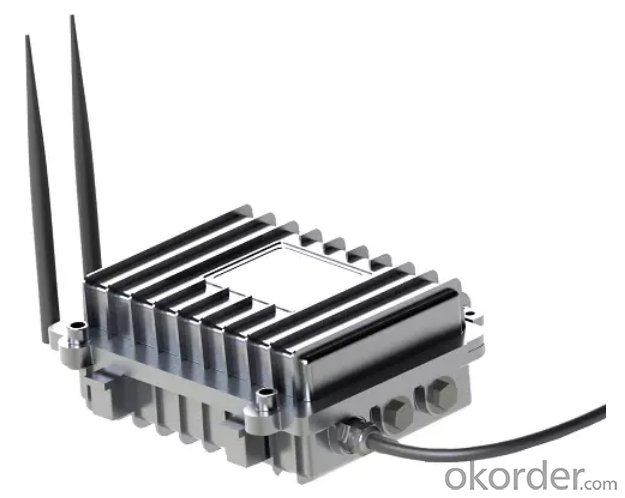
4. FAQ
Q:DO YOU HAVE ANY CERTIFICATION FOR YOUR PRODUCTS?
A:We have ISO9001:2015,CE、RoHS certifications for all of our products.
Q:DO YOU HAVE MOQ FOR PLACE ORDER?
A:Low MOQ,1pe for sample checking is availabl
- Q: How does a solar controller handle power fluctuations in the grid-tied system?
- A solar controller is an essential component of a grid-tied system that helps manage power fluctuations from the grid. When there are power fluctuations in the grid, such as sudden voltage spikes or drops, the solar controller acts as a mediator to stabilize the flow of power between the solar panels and the grid. One of the primary functions of a solar controller is to monitor the voltage and frequency of the grid. It constantly measures the incoming power and compares it to the predefined range of acceptable values. If the voltage or frequency deviates from the set parameters, the solar controller takes appropriate action to mitigate the fluctuations. In the event of a power surge from the grid, the solar controller employs various protective mechanisms to safeguard the system. It can temporarily disconnect the grid connection or utilize surge protection devices to prevent the excess voltage from damaging the solar panels or other connected equipment. Similarly, if there is a sudden drop in the grid voltage, the solar controller can regulate the power flow to compensate for the lower input. It may adjust the inverter settings or temporarily disconnect the grid connection if the voltage falls below a certain threshold. This prevents potential damage to the solar panels and ensures a stable power supply to the connected loads. Furthermore, a solar controller also plays a crucial role in maintaining the stability of the grid-tied system during grid outages. In such situations, the solar controller is programmed to immediately isolate the system from the grid to prevent back-feeding, which could pose a risk to the utility workers trying to restore power. Once the grid is restored, the solar controller verifies the stability before re-establishing the connection. Overall, a solar controller is capable of effectively handling power fluctuations in a grid-tied system by constantly monitoring and regulating the flow of power. Its ability to detect deviations, provide protection against surges or drops, and maintain grid stability makes it an indispensable component for a reliable and efficient solar energy system.
- Q: What is the maximum number of charging stages supported by a solar controller?
- The maximum number of charging stages supported by a solar controller can vary depending on the specific model and manufacturer. However, it is common for solar controllers to support up to three charging stages, which typically include bulk charging, absorption charging, and float charging.
- Q: Can a solar controller be used with solar-powered camping equipment?
- Yes, a solar controller can be used with solar-powered camping equipment. A solar controller helps regulate the flow of electricity from the solar panels to the camping equipment, ensuring efficient charging and preventing overcharging or damage to the equipment's batteries.
- Q: How does a solar controller handle battery overvoltage protection?
- A solar controller handles battery overvoltage protection by monitoring the voltage level of the battery. When the voltage exceeds a certain threshold, the controller activates a protection mechanism to prevent further charging. This can include reducing or stopping the flow of current from the solar panels to the battery, thereby preventing overcharging and potential damage to the battery.
- Q: What is the boost charging mode of a solar controller?
- The boost charging mode of a solar controller is a feature that allows the controller to increase the voltage and charge rate to the battery to quickly reach its maximum charge capacity. This mode is typically used when the battery is deeply discharged or when there is limited sunlight available.
- Q: Can a solar controller be used with solar-powered mobile charging stations?
- Yes, a solar controller can be used with solar-powered mobile charging stations. A solar controller helps regulate the flow of power from the solar panels to the charging stations, ensuring efficient charging and preventing overcharging of the batteries. It also protects the charging stations from voltage spikes and other electrical issues. Therefore, using a solar controller is highly recommended for optimal performance and safety of solar-powered mobile charging stations.
- Q: Can a solar controller be used with different battery types (e.g., lead-acid, lithium-ion)?
- Yes, a solar controller can be used with different battery types such as lead-acid and lithium-ion. Solar controllers are designed to regulate and optimize the charging process of batteries, regardless of the battery chemistry. However, it is important to ensure that the solar controller is compatible with the specific battery type being used to ensure efficient and safe operation.
- Q: Are solar controllers necessary for all solar panel installations?
- Not all solar panel installations require solar controllers, also known as charge controllers. The decision to use a solar controller depends on the specific characteristics of the solar panels and the overall system design. Solar controllers are primarily used in off-grid solar panel installations, where the panels are not connected to the electrical grid. In these setups, a solar controller is essential as it regulates the flow of electricity from the panels to the battery storage system. It ensures that the batteries are maintained at optimal levels and protected from damage by monitoring their state of charge and temperature, preventing overcharging. In contrast, grid-tied solar panel installations, where the panels are connected to the electrical grid, usually do not require solar controllers. In these setups, the electricity generated by the panels is immediately fed into the grid, eliminating the need for battery storage. The grid serves as the storage system, eliminating the need for a charge controller to manage the flow of electricity. However, it is important to note that some grid-tied systems may still incorporate a solar controller if they have additional components like batteries or if they operate in areas with an unreliable grid connection. In such cases, the solar controller would be responsible for managing the battery charging and discharging process, ensuring the system's efficiency and longevity. Ultimately, the necessity of a solar controller depends on the specific requirements and design of the solar panel installation. It is advisable to consult with a professional solar installer or engineer to determine if a solar controller is necessary for a particular system.
- Q: Can a solar controller be used with solar panel monitoring systems?
- Yes, a solar controller can be used with solar panel monitoring systems. A solar controller ensures the optimal charging and protection of the batteries connected to the solar panel system. It regulates the flow of electricity from the panels to the batteries, preventing overcharging and damage. By incorporating a solar controller into the system, the performance and efficiency of the solar panel monitoring system can be enhanced, providing accurate and reliable data on solar panel output and performance.
- Q: Can a solar controller be used with solar panels that are connected to a solar street light?
- Yes, a solar controller can be used with solar panels that are connected to a solar street light. A solar controller, also known as a charge controller, is an essential component in a solar power system that regulates the flow of electricity from the solar panels to the battery and prevents overcharging or over-discharging. In the case of a solar street light, the solar panels generate electricity during the day and charge the battery via the solar controller. The solar controller then ensures that the battery is charged to its optimal capacity and protects it from any damage caused by overcharging. During the night, the solar controller allows the battery to power the street light efficiently. Therefore, a solar controller is an integral part of a solar street light system to ensure proper charging and efficient use of solar energy.
Send your message to us
IoT Wireless Centralize Controller Remote Monitor System MPPT Solar Charge Controllers 20A
- Loading Port:
- China main port
- Payment Terms:
- TT OR LC
- Min Order Qty:
- 1 pc
- Supply Capability:
- 10000 pc/month
OKorder Service Pledge
OKorder Financial Service
Similar products
Hot products
Hot Searches
Related keywords
